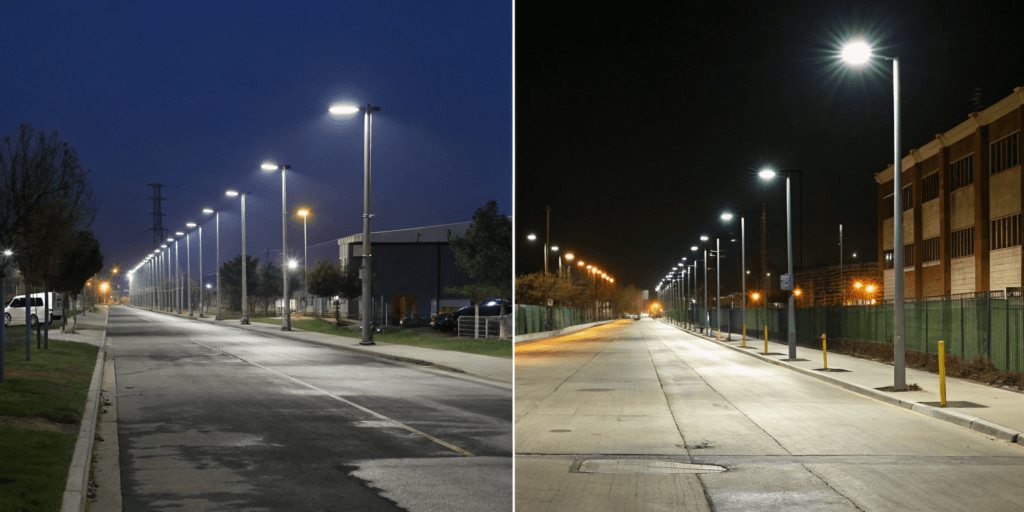Many rural villages fall into complete darkness after sunset. But with the right planning, solar street lights can change that.
This case study shows how we, as on-the-ground engineers, brought reliable and safe lighting to a rural community—improving safety, mobility, and life after dark.
I’ve been working on street lighting projects for over a decade. This isn’t just another job—it’s about bringing light where it’s most needed. What we did here proves that with the right method and cooperation, solar lighting can transform even the most remote areas.
Why Solar Street Lights Matter in Rural Communities?
Many rural places lack proper lighting due to missing grid infrastructure or unreliable electricity.
Solar lighting offers a practical and durable solution without the need for grid extension or expensive fuel.
Dive deeper: What we saw in the field
In areas where I’ve worked—especially in East and West Africa—the challenges are always the same:
- High rates of theft or accidents at night
- No safe routes for women and children after dark
- Local markets and schools forced to close early
- Over-reliance on kerosene lamps and generators
Solar street lights solve all of these with lower operational costs and faster deployment.
Background of the Rural Community Before Implementation?

The project site was a rural village in northern Uganda with about 4,000 residents.
Electricity access was limited to a few homes and a small clinic that used a diesel generator.
Dive deeper: What we found on our first site visit
During our first assessment:
- We saw unlit roads, especially around schools and markets.
- The local clinic had no exterior lighting, posing a safety risk.
- There had been a recent accident involving a child on a dark path.
- Villagers expressed strong interest in lighting, even offering help during installation.
There was a clear need—and community readiness—for a sustainable lighting solution.
Objectives of the Solar Street Lights Installation?
Before any pole went up, we defined our goals clearly. This wasn’t just about dropping hardware—it was about changing daily life.
Dive deeper: Practical goals from our engineering team
We had three main objectives:
- Improve public safety, especially near schools, clinics, and markets
- Reduce community dependence on generators and kerosene
- Help small businesses stay open later by providing safe lighting
We made sure that every lighting point served multiple people and places. Placement had to be strategic—not random.
Site Selection and Community Involvement?

Choosing the right sites was critical. We did it hand-in-hand with the community.
Dive deeper: How we approached location planning
As engineers, we usually rely on maps and traffic studies. But here, we did something extra—we walked the village with local leaders.
We identified:
- Unlit public paths where accidents had occurred
- Busy market junctions
- Areas near water collection points and schools
We also organized feedback meetings. The community ranked priority zones, and we adjusted our plan accordingly.
This input helped us place 25 poles where they would have the most daily impact.
Type of Solar Street Lights Used?
We selected durable units that could operate year-round in outdoor environments with minimal maintenance.
Dive deeper: Equipment specs from our BOM (Bill of Materials)
Each street light included:
- 40W LED head (IP65, 6000K)
- 100W monocrystalline solar panel
- 60Ah LiFePO4 lithium battery (mounted on the pole)
- Smart controller with motion sensor and dusk-to-dawn timing
- Galvanized steel pole, 6 meters tall
These were all-in-one integrated systems, which made installation much faster. We chose motion-based dimming to reduce battery usage after midnight.
| Component | Specification |
|---|---|
| LED Fixture | 40W, 6000 lumens, 6000K color temp |
| Battery | 60Ah LiFePO₄, 12.8V, 3-day autonomy |
| Panel | 100W mono, efficiency ≥18% |
| Controller | MPPT + motion sensor + timer |
| Pole | 6m hot-dip galvanized steel |
Installation Process and Timeline?

This project was completed in 8 weeks from start to finish, including site preparation.
Dive deeper: How we got it done on the ground
Week 1–2: Site surveying, base casting
Week 3–4: Material delivery from our central warehouse
Week 5–8: Installation and testing
- Poles were anchored with concrete bases (M20 bolts)
- We used a team of 3 trained technicians per site
- Local volunteers helped with trenching and logistics
We also trained one community representative on simple maintenance, such as cleaning the solar panels and resetting controllers.
Challenges Faced During Implementation?
Working in remote areas always comes with surprises.
Dive deeper: Real problems, practical solutions
- Transport Issues: Some delivery trucks got stuck on muddy roads. We offloaded manually and used motorbikes for battery transport.
- Weather Delays: Rain delayed base curing. We used temporary sun shelters to speed up the process.
- Vandalism Risk: We held a town hall meeting and agreed to assign watch volunteers during the first month.
One unexpected win: After installation, some villagers offered to clean the panels weekly in exchange for training on solar systems.
Social and Safety Improvements?

Within two weeks of going live, the difference was visible—literally.
Dive deeper: What changed on the ground
- The market stayed open until 9 PM instead of 6 PM.
- Reported incidents near schools dropped to zero.
- Two new informal businesses—tea stalls—opened under the new lights.
We also saw more evening church services and study groups. Lighting became a central part of community life.
Economic Impact of Solar Street Lights?
Lighting gave the economy a small but steady boost.
Dive deeper: What the numbers showed us
- Market sellers increased sales by 15–20% with extended hours
- 5 part-time jobs were created for cleaning and routine checks
- Two local technicians were trained and retained by the village council
These are modest gains, but they add up quickly in villages where every extra hour of trade matters.
Environmental and Energy Impact?
No wires, no fuel, no emissions.
Dive deeper: What solar lighting replaced
Before installation:
- Some shops used petrol generators at night
- Homes relied on kerosene lamps or candles
Now:
- Generator use dropped by 80% in the market area
- Families reported cleaner air and fewer burns from lamp accidents
- Estimated CO₂ reduction: 4–5 tons annually
Key Success Factors and Lessons Learned?

Success didn’t come from tech alone. It came from trust, training, and transparency.
Dive deeper: What we’ll always do again
- Involve the community early and often
- Use tested, high-quality equipment—even if it costs more
- Plan for maintenance before installation
- Keep everything simple, clear, and field-proven
We also found that even small gestures—like giving villagers a role in the install—build long-term ownership and protection.
Recommendations for Future Solar Street Light Projects?
Others can learn from this and do even better.
Dive deeper: My advice to engineers and project leaders
- Always start with a field visit—don’t rely only on satellite maps
- Choose light models with motion dimming to extend battery life
- Train two locals per 10 poles on basic troubleshooting
- Include lockable battery boxes to reduce theft
- Document everything—future repairs depend on your notes
Most importantly, be on-site during installation. Remote coordination doesn’t work in rural terrain.
Conclusion: Empowering Rural Communities with Solar Street Lights
Solar street lights don’t just illuminate roads—they unlock safety, business, and social life. With careful planning and strong community involvement, any rural village can move from darkness to opportunity.
Frequently Asked Questions About Solar Street Lights in Rural Areas
How much do solar street lights cost?
Between $300 and $800 depending on specifications and shipping.
How long do solar street lights last?
LED heads last 8–10 years. Batteries last 4–6 years with good management.
What kind of maintenance do they need?
Clean solar panels every 3–4 months. Check bolts and connections twice a year. Replace batteries as needed.


